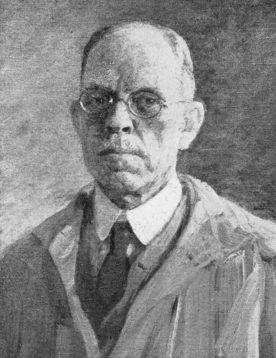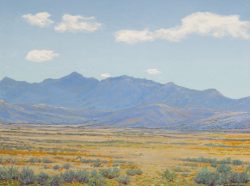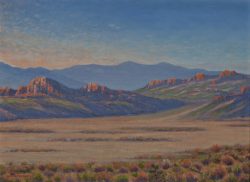Wallace L. DeWolf, from a portrait reproduced in Paul Gilbert and Charles Lee Bryson, Chicago and Its Makers (Chicago: F. Mendelsohn, 1929).

Wallace DeWolf 1854–1930
The scion of one of Chicago’s most prominent families, Wallace Leroy DeWolf grew up intending to become an attorney. After high school, he studied at Union College of Law (predecessor of the Northwestern University College of Law) and entered into practice; by the mid-1890s he also was successfully involved in real estate and other business endeavors. Well-read and widely traveled, the affluent DeWolf taught himself to paint in 1911 while recuperating from a serious illness. He took up landscape painting in earnest in 1912 and two years later began exhibiting his work at the Art Institute of Chicago. He also was an avid printmaker and collector of prints. As a businessman-turned-artist, DeWolf followed the lead of his close friend Edward Burgess Butler, with whom he traveled to the American Southwest to paint landscapes; the two exhibited together and were among the founders of the Business Men’s Art Club in 1920. A frequent visitor to Pasadena, California, DeWolf joined several art organizations in Southern California and bequeathed significant gifts to the Pasadena Art Institute, of which he served as a trustee.
In Chicago, DeWolf was active both as an artist and as an art patron. He was a member of such influential organizations as the Cliff Dwellers club and the Union League Club of Chicago as well as the Chicago Society of Artists and the Chicago Society of Etchers, among other organizations. He was both a regular exhibitor in and juror for the Art Institute’s annual shows, a trustee of the museum, and an active supporter of its department of prints, to which he gave his collection of etchings by Swedish master Anders Zorn in 1913. DeWolf’s landscape paintings and etchings portray a variety of natural settings ranging from the Canadian Rockies to Vermont; closer to home, he painted landscapes in Chicago’s North Shore suburbs, where he lived in Highland Park. Desert views were his particular specialty, however. In 1917 and 1919, the Art Institute held solo exhibitions of his recent paintings and etchings, with all proceeds from sales benefiting the museum and school. Diagnosed with a terminal illness, DeWolf took his own life at age seventy-six in Pasadena, his wintertime residence.
Wendy Greenhouse, PhD

